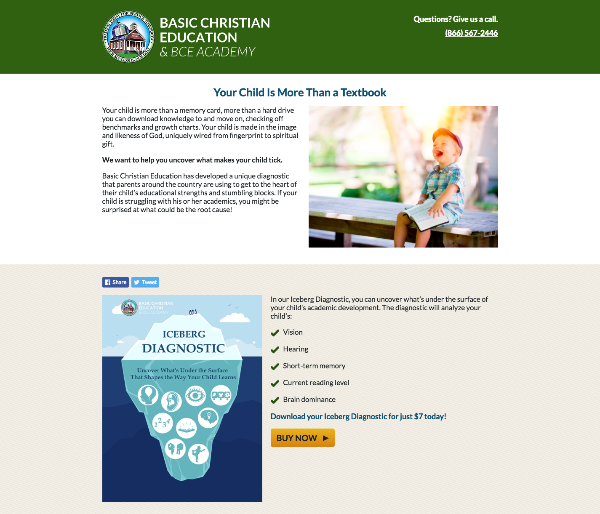Where Leads Are Getting Lost on Your Landing Page and How to Reroute for Conversions
Author: Jeremy Harrison
Whether we know it or not, we’ve all found ourselves on a landing page or two.
A landing page is built around a single product/service/lead magnet/etc. with a specific desired result in mind. Marketers send traffic through ads, social channels, or links on other portions of the website to a landing page, which can be a NEW page of content or an existing page on a site that is written explicitly for marketing purposes. The routes may range from off-roading it from a billboard link to flying direct from an email campaign and a million other variations (social ads, Google ads, search results, etc.), but the arrival location—the landing page—remains the same.
What you, or any lead on the page, decides to do next is critical to an impactful marketing campaign:

When we set up landing pages, we picture the happily ever after. Potential customers fill out the form to express interest in the product or service, and form submissions blow up your inbox.
*Cue the fireworks from every game of solitaire you’ve ever won.*
This is the ideal scenario but not always the actual scenario. Sometimes, your potential customer pulls into your landing page parking lot only to do a 180 back out. This happens for multiple reasons.
Leads are people, and people get cold feet. They often get lost on web pages that aren’t optimized to fix an issue they’re facing. Detour routes can pop up all over a page if you’re not sure where those wrong turns occur.
If you know where your landing page traffic gets lost, you can start removing the detour signs:
Remove the Website Navigation
When a new lead from your advertisement hits your landing page, they probably didn’t enter through your website first, and that’s okay! By removing your website’s navigation, your lead isn’t distracted by the other pages of the website. They can focus on exactly what it is you’re wanting them to do, which is pay attention to your product or service!

See how this landing page has zero site navigation? The lead doesn’t question if they’re on the right page because there’s only one page to be on, with a clear, focused mission: take this next step.
Simplify and Problem Solve in Your Headline
Headlines are a clever way to catch someone’s eye and pull them into your content. When writing your landing page, remember headlines are the key to letting leads know what you’re offering.
Bad example of a headline:
You Need THIS to Improve your Business
Why it’s bad: Marketing is always changing because consumers quickly recognize marketing tactics. This screams click bait and can drive potential leads away.
Good example of a headline:
Market Your Small Business Like a Boss and Still Save Money with [PRODUCT/SERVICE]
Why it’s good: This solves two problems businesses face, marketing and saving money.
The *good* headline example is also simple to understand. In a matter of seconds, I know what this page will be about and how it solves my problem. If you’re not sure how to frame your marketing strategy to solve instead of sell, check out this article from Spire’s Director of Sales, Bryan Lefelhoc.
Establish a Connection with Your Audience
I can’t stress this enough. People will not engage with your brand – in any way – unless they feel connected to you. This is quite simple to do using inbound marketing. Allow the leads that land on your page to place themselves in your brand’s story.
Here are a few ways how:
- Use images that look and feel like your audience. If you’re selling pet products, use pictures of happy pet owners taking care of their animals.
- Use language that makes sense to them. Speak to their problems and voice why your business benefits their lives. This is a great opportunity to use social proof tactics and show you’re just as much a person as they are!
Highlight the Perks with Icons
You know that one person who HATES reading? Maybe it’s someone in your family or a close friend; maybe it’s even you. Regardless, no one has the time or patience to read eight paragraphs before learning why they should buy your product or service.
Guide your leads towards why your product or service is so awesome using icons or bullet points. This is a simple, yet effective way to break down the content on your page and keep leads on track.
Don’t Make Leads Scroll to Convert
This is an easy tip to make your landing page rock. Keep your call-to-action “above the fold.” This means keep it in the top half of the page where the lead can easily see without having to scroll down. In addition to that, using a colored button for your CTA (like in checklist example above) draws the eye for visitors.
Long Forms + Limited Time = No Submissions
Our world is constantly on the go. Odds are, the customers coming to your landing page are on their phones. To capture valuable lead information, keep it short and sweet. Ask for the following:
- Name
- Phone
This allows leads to quickly fill out the form no matter if they’re in a rush or in between Netflix episodes.
Hint: You can also generate a 2-step form that captures initial information like name, phone, and email. Once the lead has filled out “step one,” they have the option to fill out “step two” immediately or wait until they have more time on their hands.
You are the guide for your target audience. Think of yourself as their GPS when they are driven to your landing page. Keep the road clear and avoid detours that could confuse them, such as site navigation and unclear headlines. Leads need to know what the page is about and how it solves their problem. People recognize landmarks, so use images and icons to help steer them in the right direction towards your call-to-action.
Landing pages are fun for both businesses and consumers. Using these tips to help leads find their way creates an enjoyable end user experience and results in form submissions. If you find yourself struggling or have questions about best practices on landing page creation, we’re here to help. Connect online or give us a call at 419-496-4212 and we’ll get you where you need to be.
Happy lead driving!
